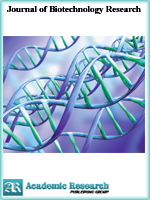Journal of Biotechnology Research
Online ISSN: 2413-3256
Print ISSN: 2413-8878
Print ISSN: 2413-8878
Quarterly Published (4 Issues Per Year)

Archives
Volume 6 Number 4 April 2020
Isolation Purification and Partial Characterization of Antisnake Venom Plant Peptide (BRS-P19) from Bauhinia rufescens (LAM FAM) Seed as Potential Alternative to Serum-Based Antivenin
Authors: I. Sani ; A.A. Umar ; S.A. Jiga ; F. Bello ; A. Abdulhamid ; I.M. Fakai
Pages: 18-26
DOI: doi.org/10.32861/jbr.64.18.26
Abstract
Several studies have been reported on active peptides isolated from some medicinal plants, which were effective inhibitors against snake venom induced toxicities. Hence, the aim of this research work was to isolate, purify and characterize an antisnake venom plant peptide from Bauhinia rufescens seed that can serve as potential alternative to serum-based antivenins. B. rufescens seed was collected, duly identified, authenticated and processed. The peptide was isolated from the seed and purified using gel filtration chromatography and SDS-PAGE and then named as BRS-P19. Venom Phospholipase A2 (VPLA2) was used for the study and was isolated from Naja nigricollis venom. Albino mice of both sexes were used for in vivo experiments. They were divided into seven (7) groups of three (3) mice each. Group 1 served as normal control, group 2 were injected with VPLA2 only, group 3 and 4 were injected with VPLA2 then treated with BRS-P19 at doses of 0.2 and 0.4 mg/kg b.w. respectively, while mice in group 5 were injected with VPLA2 then treated with standard antivenin, group 6 and 7 were injected with VPLA2 followed by administration of ascorbic acid and α-tocopherol respectively. In all the groups, hepatic and renal levels of reactive oxygen species (ROS), lipid peroxidation (MDA) and activities of antioxidant enzymes were determined. The results showed that, the BRS-P19 has molecular weight of ~19kD. Its percentage in vitro inhibitory effect against VPLA2 was 91.85 ± 0.32%. For the in vivo study, the animals treated with 0.4 mg/kg b.w. of the BRS-P19 showed a significant (P<0.05) decrease in the hepatic and renal ROS and MDA levels when compared with the VPLA2 untreated group. But, the activities of the antioxidant enzymes in all the treated groups were significantly (P<0.05) increased by the BRS-P19 at 0.4 mg/kg b.w. when compared to the VPLA2 untreated group. Based on these findings, it has been established that, BRS-P19 has antisnake venom effect through inhibition of VPLA2 and antioxidant activity as the possible mechanisms of action.



